Elbow Pain from Pull Ups: Reasons and Solutions
Author:
Reviewed by:
(21 years of Oly Lifting experience)
Unlock your full potential by engaging with our experts and community! Have questions about your fitness journey or looking for expert advice on weightlifting techniques? Don’t hesitate — leave a comment below and David Sasha Schulz will provide a personalized answer and insights to help you reach your goals.
Torokhtiy is reader-supported. Some links are affiliate links, and we may earn a commission at no extra cost to you. See our disclosure page for details.
In strength training we embark in the endless pursuit of getting better and stronger. In this pursuit, the pull up stands as a staple exercise, requiring endurance, resilience and high grip strength.
Nevertheless, as with many exercises, the pull up and its mastery can come with a persistent enemy: elbow pain. In this article, we will embark on a journey into understanding the pull up and why it can come with elbow discomfort.
The pull up, one of the fundamental strength exercises in the arsenal of strength training enthusiasts, activates a lot of muscles, tendons and joints. While we all know all its ¨pulling strength¨ benefits, the strain it puts on the elbow joint is well known among athletes.
As we study this issue, we will understand the biomechanics and anatomy, understanding as well as the causes of elbow pain from pull ups and what we can do about it.
Are pull ups the root of your elbow pain? – Yes, you can start getting elbow pain from pull ups. This exercise produces a lot of strain in the elbow joint and tendons, proper form and equally important warm up can help you adjust and adapt for improving your pull ups.
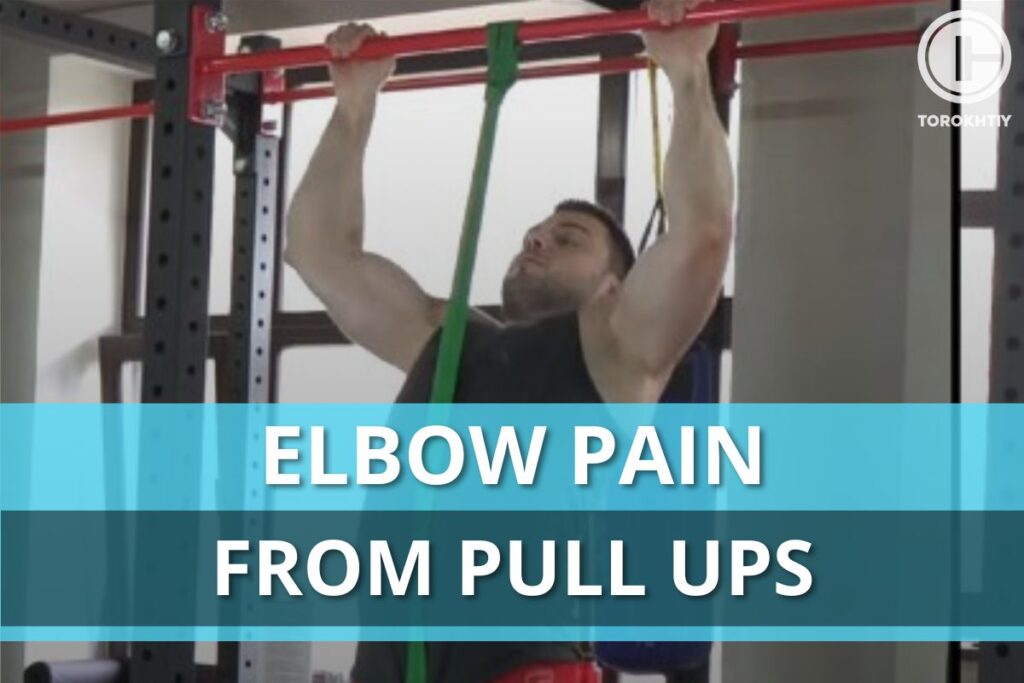
What Causes Elbow Pain from Pull-Ups?
Elbow pain after pull ups often comes from overuse or improper form. The possibilities are between hyperextension or putting too much tension on the tendons, leading to discomforts like the common ‘medial epicondylitis’ or golfer’s elbow.
Let’s get through some of the possible causes of pain:
1. Repetitive Strain and Overuse
Performing an excessive amount of pull ups without the proper rest can strain the elbow joints and tendons, possibly causing tendon microtrauma from repeatedly putting so much tension and overtime leading to inflammation and pain.
Pull Ups require you to put a significant load on the forearms and elbow tendons, overusing this makes the load even bigger and potentially exceeding the capacity of the tendon to handle the tension and stress.
2. Incorrect form
Pull Ups are performed with an overhand grip (palms facing away from you) with your hands slightly wider than shoulder-width apart. Biomechanically, pull ups use shoulder adduction as the elbows pull down and back from the sides during the movement, training the lats and upper back in a slightly different way than chin ups.
Straying from this technique, for example, using too wide a grip on the bar, could make the exercise more challenging, possibly cousin tendonitis and leading you to having elbow pain when doing pull ups.
3. Muscle Imbalances
In pull ups, various muscle groups are involved: shoulders, forearms, triceps, biceps, upper back, lower back and abs. Having, for example, weakness in forearm and grip strength can contribute to discomfort and potential strain during pill-ups, possibly affecting the tendons of the elbow.
4. Insufficient Warm-up
We all know that warm up is important, it makes the blood flow, makes the body feel better, but most ignore that a proper warm up can help reduce the risk of injury by preparing your tendons and muscles for the workout.
5. Improper Rehabilitation
If we fail to address a former elbow pull up injury and provide proper rehabilitation, it we could be opening a gateway for a resurface of that injuryю. If the tendons and muscles are not ready to go back and have all that tension on them it coy¡uld result into a worse injury and possibly having to stop for longer than before.
How to Treat and Prevent Elbow Pain From Pull Ups? (Diagnosis, Recovery, Treatment)
Elbow pain from pull ups could also be called tennis elbow or golfer’s elbow, it is a condition that causes pain around the inside of the elbow. It’s clinically known as lateral epicondylitis. It often happens after overuse or repeated action of the muscles of the forearm, near the elbow joint. You may notice pain on the outside of the elbow, which may travel down the forearm when:
- lifting or bending your arm
- when gripping small objects, such as a pen
- when twisting your forearm, such as turning a door handle or opening a jar
You may also find it difficult to fully extend your arm.
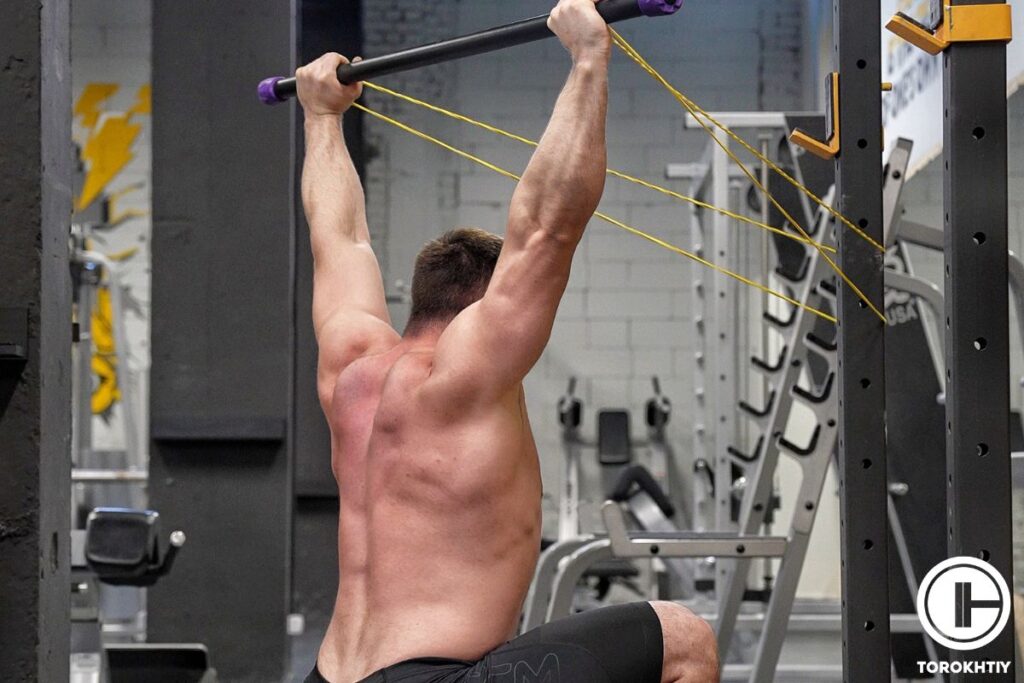
Tennis elbow will get better without treatment (known as a self-limiting condition). It could last between 6 months and 2 years, with most people (90%) making a full recovery within a year. The most important thing to do is to rest your injured arm and modify the exercise that caused the problem.
There are also simple treatments to help with the pain, like holding a cold compress, such as a bag of frozen peas wrapped in a towel, against your elbow for a few minutes several times a day. Let’s number a couple of strategies we can use when we’re faced with Elbow pain:
1. Painkillers and Non-steroidal Anti-inflammatory Drugs (Nsaids)
Taking painkillers, such as paracetamol, and NSAIDs, such as ibuprofen, may help ease mild pain and inflammation caused by tennis elbow. NSAIDs are available as tablets or creams and gels (topical NSAIDs), which are applied directly to the area of your body where there is pain.
Topical NSAIDs are often recommended for musculoskeletal conditions, such as tennis elbow, rather than the other versions. This is because they can reduce inflammation and pain without causing side effects, such as feeling sick (nausea) and diarrhea. Some NSAIDs are only available with a prescription. A GP or pharmacist will be able to recommend a suitable NSAID.
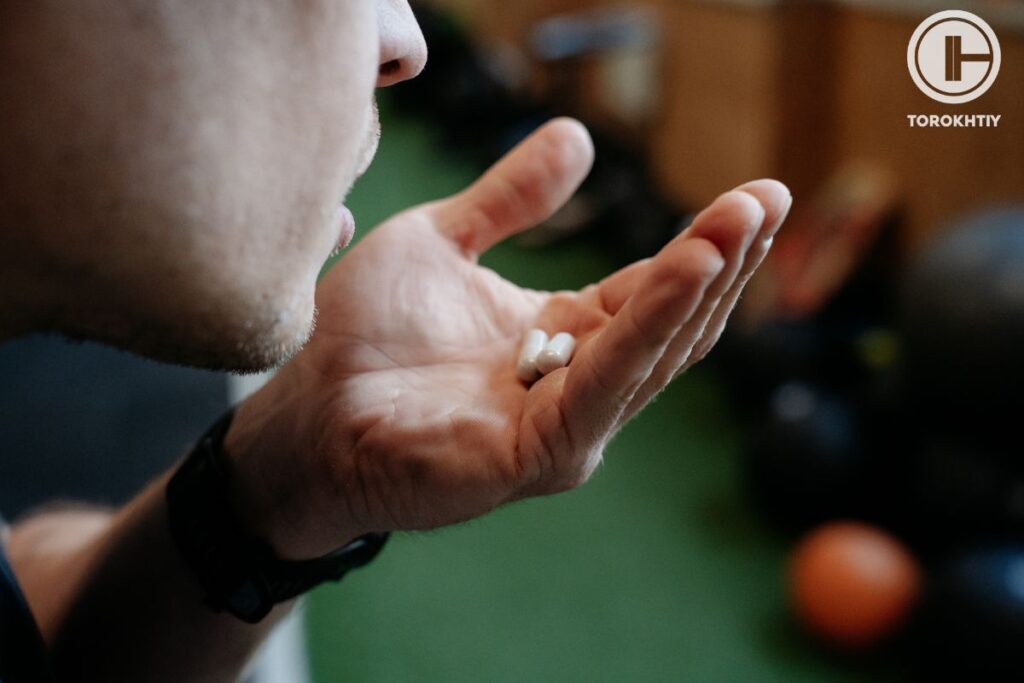
2. Physiotherapy for Elbow Pain
The specialist may refer you to a physiotherapist if your elbow pain is causing more severe or persistent discomfort. Physiotherapists are healthcare professionals who use a variety of methods to restore movement to injured areas of the body.
The physiotherapist may use manual therapy techniques, such as massage and manipulation, to get rid of the pain and stiffness. They can also teach you some exercises you can do to keep your arm mobile and strengthen your forearm muscles.
The use of a brace, strapping, support bandage or splint (called an orthosis) may also be recommended in the short term.
3. Shockwave Therapy for Elbow Pain
Shockwave therapy is a great optional treatment for care as it is a non-invasive treatment, where high-energy shock waves are passed through the skin to help ease pain and promote movement and recovery in the area treated.
The number of sessions you will need depends on the injury and patient. In some cases you may have a local anesthetic to reduce any pain or discomfort during the procedure.
Shockwave therapy, while completely safe, can cause quite minor side effects that could include bruising and reddening of the skin in the area treated. Some research shows that shockwave therapy can help improve the elbow pain. However, it may not be as effective in all cases, and further research is needed.
4. PRP Injections for Elbow Pain
Platelet rich plasma (PRP) is a treatment sometimes offered by surgeons hospitals to treat elbow pain.
PRP is blood plasma that contains concentrated platelets that your own body uses to repair damaged tissue. Injections of PRP have been shown to speed up the recovery process in some, but their long-term effectiveness is not yet established.
The specialist will take a blood sample from you and place it in a machine. The process separates the healing cells so they take it from the blood sample and inject it into the affected joint. The procedure could take from 30 – 60 minutes.
Follow us!

Free!
Get a 2-week Weightlifting Program as a bonus for the subscription to kickstart your training plan!

Free!
3 Treatment Exercises to Minimize Elbow Pain
When dealing with elbow pain after pull ups we can have a big array of treatments we can add to our training sessions to start getting better and back on the bar as soon as possible, we’ll divide these exercises into three parts: Scapular muscle strengthening, wrist and elbow strengthening, and joint mobilizations. Let’s start with the first one:
1. Scapular Muscle Strengthening
In this matrix of exercises we have three that will come in handy to better our strength in the pull ups, we have:
- Lat Pulldowns: Use a cable machine for this exercise. Sit down with your knees secured under the pads, grab the bar with an overhand grip, and pull it down towards your chest while keeping the elbows close to your sides. This mimics the motion of pull-ups and strengthens the muscles involved.
- Dumbbell (or barbell) row: Stand with your feet shoulder-width apart and hold a dumbbell or a barbell in front of you. Bend your knees a little and hinge at the hips. Pull the weight towards your lower rib cage and squeeze your shoulder blades together at the top of the movement. Slowly lower the weight back to the starting position.
2. Wrist and Elbow Strengthening
Similar to the Scapular Muscle exercises, we have three exercises that will help us get stronger wrists and elbows:
- Wrist Curls: Sit on a bench or chair with your forearm resting on your thigh with your palm facing up. Curl your wrist up, then lower it back down in a controlled manner.
- Reverse Wrist Curls: Sit with your forearm resting on your thigh, holding a dumbbell with your palm facing down. Curl your wrist up, then lower it back down in a controlled way.
- Farmer’s Walk: Hold a dumbbell or kettlebell in each hand at your sides and stand up straight, Walk a set distance.
3. Joint Mobilization
These require a trained professional to perform, but here are some examples of techniques that might be used by a physiotherapist or chiropractor:
- Mulligan Mobilizations: These techniques involve a therapist applying sustained manual pressure to a joint while a patient moves through their range of motion. The goal is to reduce pain and improve mobility by realigning the joint during movement.
- McKenzie Method Treatments: This method involves exercises and movements designed to centralize pain, moving it away from the extremities and towards the spine. It focuses on self-treatment and prevention, teaching patients how to manage their symptoms and improve function through specific exercises.
How to Do Pull Ups Without Hurting Your Elbows? (3 Tips to Avoid the Elbow Pain)
Some things can come as the most simple tips but it doesn’t mean they stop being important, to avoid pull up elbow pain one of the first things we should do is:
1. Mobilize and Warm Up
Skipping our warming up prior to a set can lead us to elbow pain during pull ups or injury.
To avoid this, perform a dynamic mobility routine before you start your workout, taking extra care to mobilize the elbows through their entire range of motion.
Remember that if you are already experiencing some kind of pain, it is best to stop doing pull-ups temporarily so as to allow for the elbows and tendons to recover.
2. Avoid a Fast Increase of Intensity or Volume in Training
All our bodies need time to adapt to a certain level of intensity, with no importance of whether the exerciser is a professional athlete or a novice to resistance exercises.
With this in mind, returning to full training intensity after a period away from the gym or maybe switching to a far more advanced program without proper graduation or progression can easily lead to conditions like tendinopathy and tennis elbow.
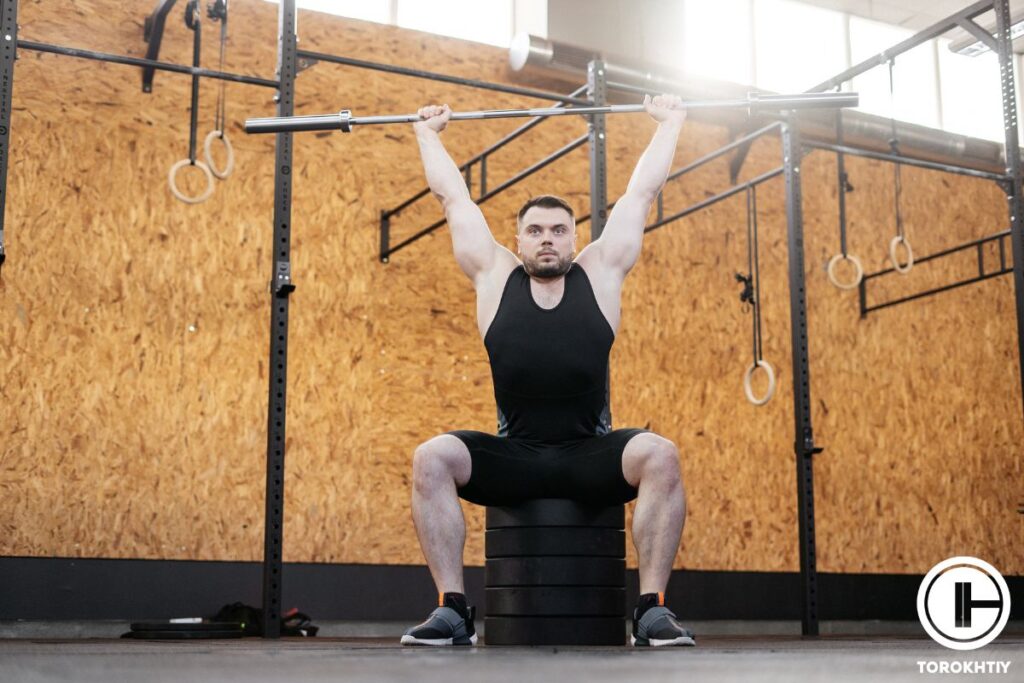
To allow the body sufficient time to adapt to its new stress, it is important to begin every new training program carefully – slowly increasing the intensity until it has achieved your desired level over the course of several sessions.
3. Allow the Elbow Tissues to Adapt to Stress
Similar to a fast increase of intensity, if the elbow tissues have not been slowly adapted to the strain of resistance training, there is a possibility for them to become injured or irritated by pull-ups.
While this is not common to occur and is easily avoided by following a proper training program, athletes jumping straight into resistance training from a sedentary lifestyle are the most likely to suffer from this problem.
To help reduce the intensity of these problems, following a training program specifically geared towards novices or even better, having a program written by a coach specifically for you is the best way to make sure that your elbows are given ample time to adapt.
FAQ
Can Pull-Ups Cause Elbow Tendonitis?
Yes, if you do too many of them, especially without proper warm-up or with an incorrect form it is possible to get elbow tendonitis from performing pull ups.
Are Pull UPS Bad for Tennis Elbow?
The pull-up places a lot of strain on your forearm, wrist, and elbow. If you notice pain in your elbow, even after a good warm-up, it’s best to see a specialist and get some rest before attempting pull-ups again. This can help prevent further injury.
Conclusions
There are many exercises to help us improve our weightlifting strength. The pull up , among others, is a great option. With its ups and downs, having all the knowledge about them and how to perform them in a correct way will make us not only stronger, but better athletes.
If you have any other questions or more tips on how to avoid elbow pain in pull ups, be sure to write them in the comment section so we can start a conversation about it.
Also read:
- Bench Press Elbow Pain: Causes, Treatments And Tips
- What Are Elbow Mobility Exercises? Everything You Need to Know
- Elbow Pain From Curls: Causes, Treatments and Tips
- Strong Arms, No Pain: Tackling Elbow Discomfort from Weightlifting
- Elbow Pain From Push Ups: Causes & Prevention
- How To Improve Grip Strength For Pull-Ups: Ultimate Guide
- Rack Pull vs Deadlift: Which Is More Effective?
References:
- Kinsey Mahaffey, ¨Chin Ups Vs. Pull Ups: The Difference, The Benefits & Muscles Worked¨, https://blog.nasm.org/chin-ups-vs.-pull-ups-the-difference-the-benefits-muscles-worked
- Ronald L. Snarr, Ashleigh V. Hallmark, Jason C. Casey, and Michael R. Esco, ¨Electromyographical Comparison of a Traditional, Suspension Device, and Towel Pull-Up¨ National Library of Medicine, September 2017.
- ¨Overview Tennis elbow¨, NHS, November 2020, https://www.nhs.uk/conditions/tennis-elbow/
- Joseph M. Day, PT, PhD, OCS, CIMT, Ann M. Lucado, PT, PhD, CHT, and Timothy L. Uhl, PT, ATC, PhD, ¨A COMPREHENSIVE REHABILITATION PROGRAM FOR TREATING LATERAL ELBOW TENDINOPATHY¨, National Library of Medicine, September 2019.
- Debbie Luna, ¨Pull Up Elbow Pain: Common Reasons Explained¨, July 2023, Inspire USA Foundation.
- Photos by Torokhtiy Media Team.
Why Trust Us?
With over 20 years in Olympic weightlifting, strength training, nutrition coaching, and general fitness our team does its best to provide the audience with ultimate support and meet the needs and requirements of advanced athletes and professional lifters, as well as people who strive to open new opportunities and develop their physical capabilities with us.
By trusting the recommendations of our certified experts in coaching, nutrition, and sports training programming, as well as scientific consultants, and physiotherapists, we provide you with thorough, well-considered, and scientifically proven content. All the information given in the articles concerning workout programming, separate exercises, and athletic performance, in general, is based on verified data.
The product testing process is described in more detail here.
Author: David Sasha Schulz
Doctor of Chiropractic, BSc Human Biology, CSCS
Strength coach (CSCS) – 10 years
Sasha is a Chiropractor and Kinesiologist practicing in Kelowna, BC, Canada. He has been practicing Chiropractic since 2019, integrating manual therapy, strength training and programming principles, and nutritional strategies to get his patients optimal results. He currently scratches the competitive itch in fitness, and the occasional endurance race, and plays golf and snowboards for fun. He has an interest in all strength and fitness-related sports.
Reviewed by: Oleksiy Torokhtiy
Olympic Weightlifting Champion, PhD in Sport Science
Best Results: Snatch – 200 kg,
C&J – 240 kg
Oleksiy Torokhtiy is a professional athlete boasting 20 years of experience in Olympic weightlifting. With multiple European and World titles under his belt, he has showcased his prowess in two Olympic Games (Beijing 2008 and London 2012). Upon concluding his illustrious career, Oleksiy dedicated himself to coaching. By 2022, he had conducted over 200 weightlifting seminars worldwide. He is the visionary behind an international sportswear and accessories brand known for its motto, “Warm Body Cold Mind.” Additionally, he is an esteemed author and the creator of a series of training programs and eBooks.




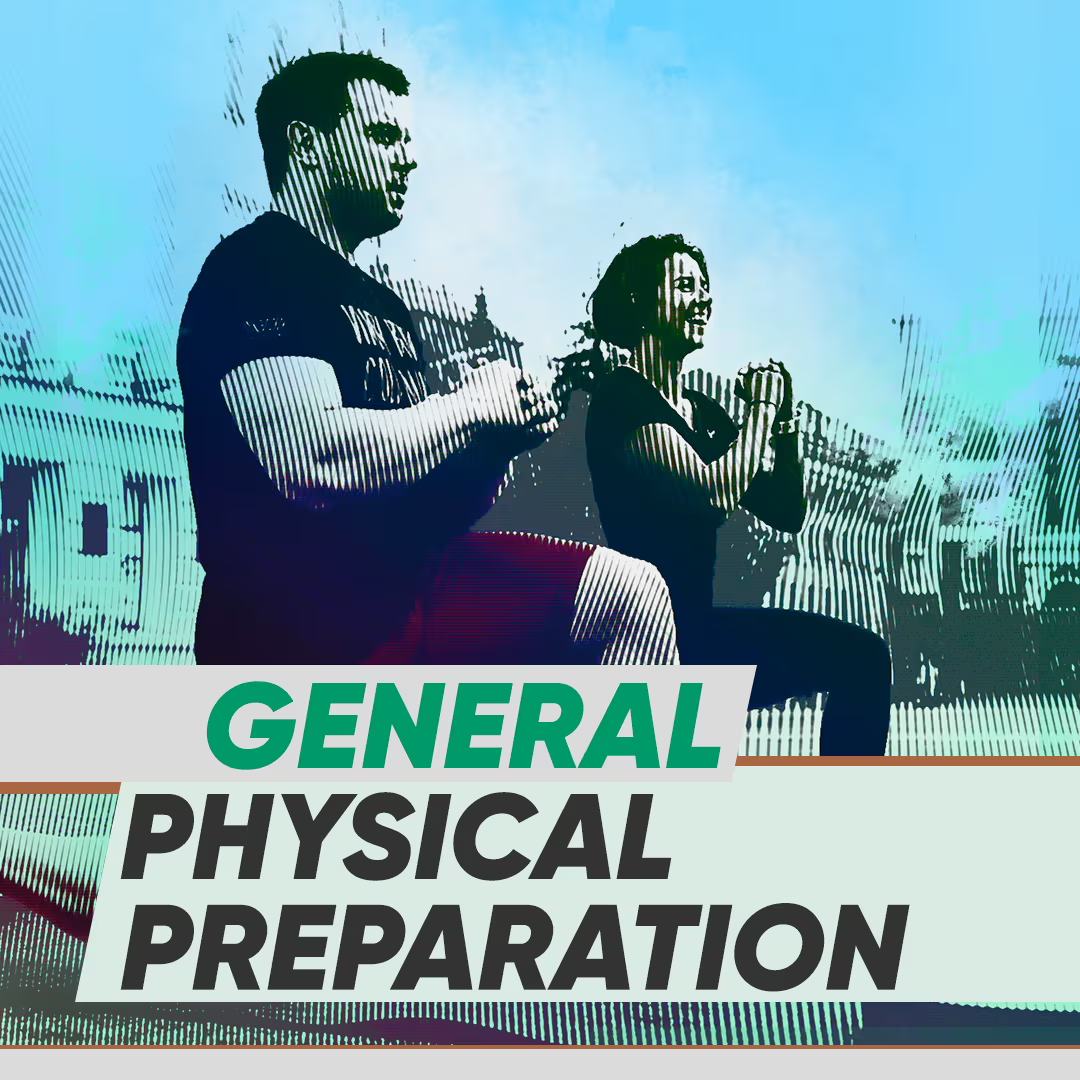
Still have questions after reading our article? Unlock your full potential by engaging with our experts and community! Don’t hesitate — leave a comment below and David Sasha Schulz will provide a personalized answer and insights to help you reach your goals.